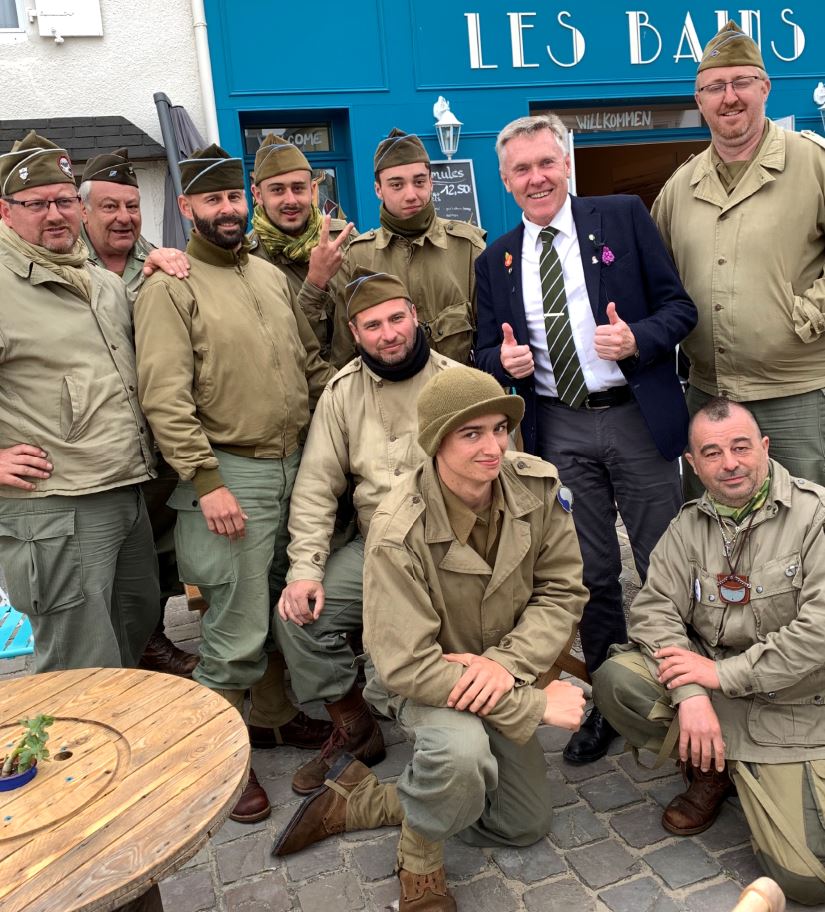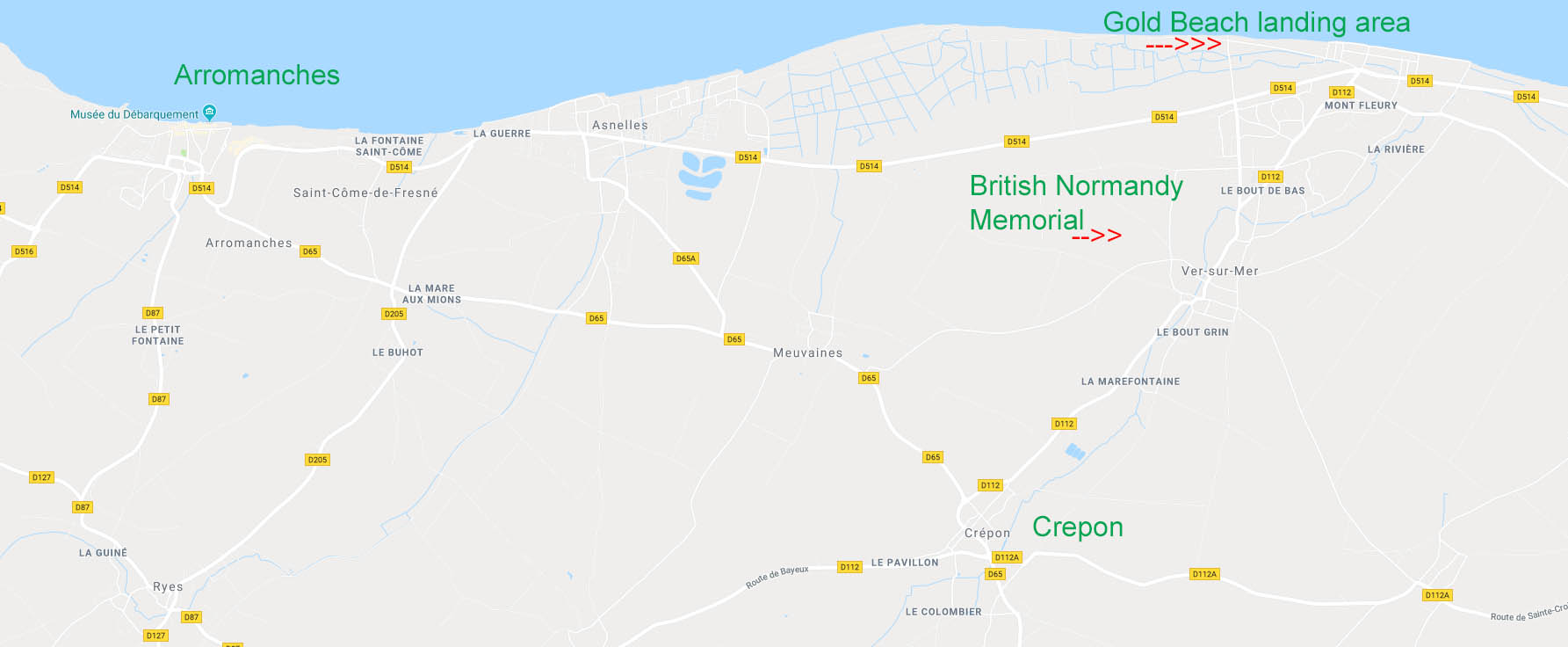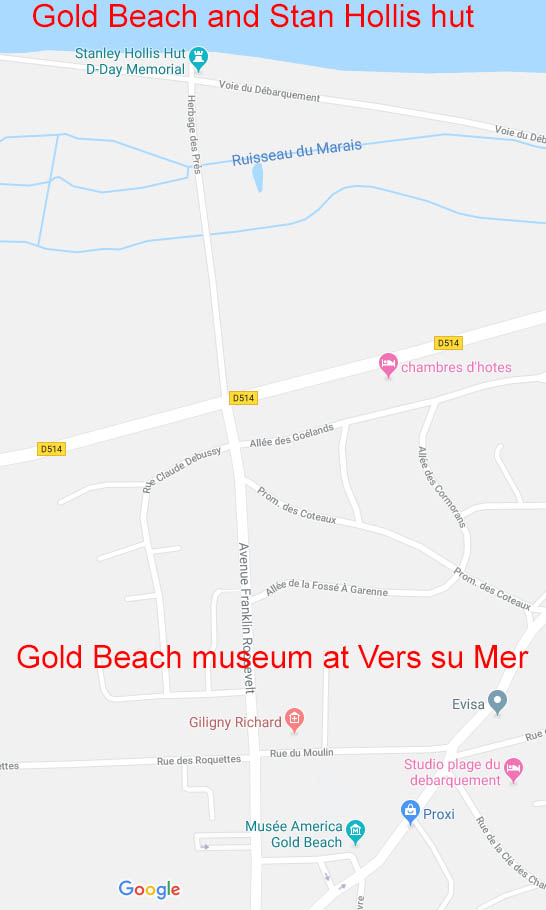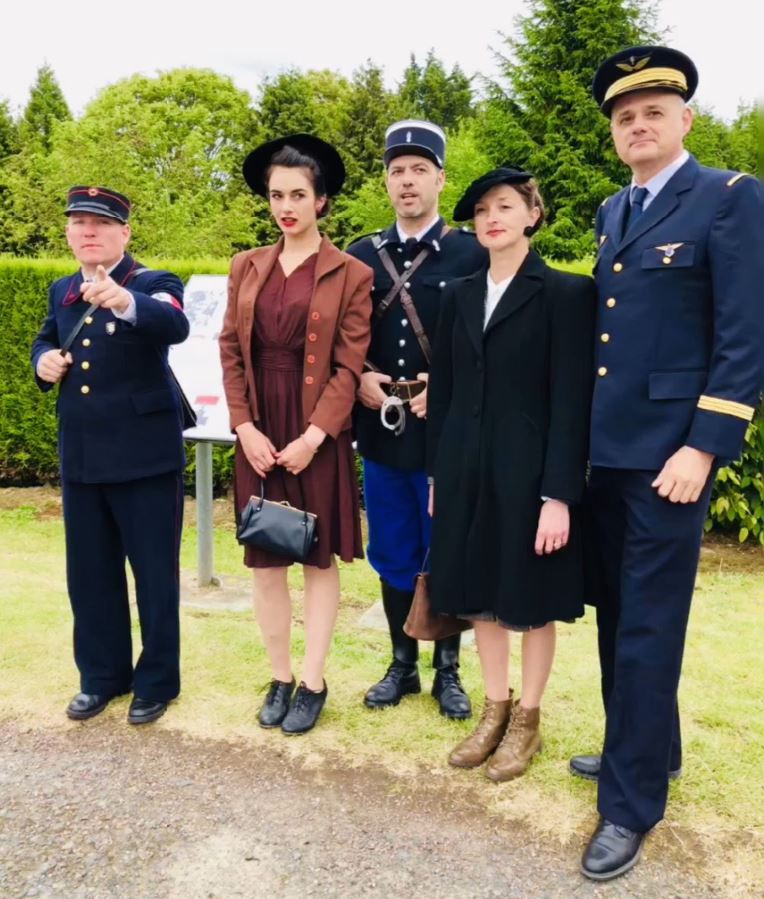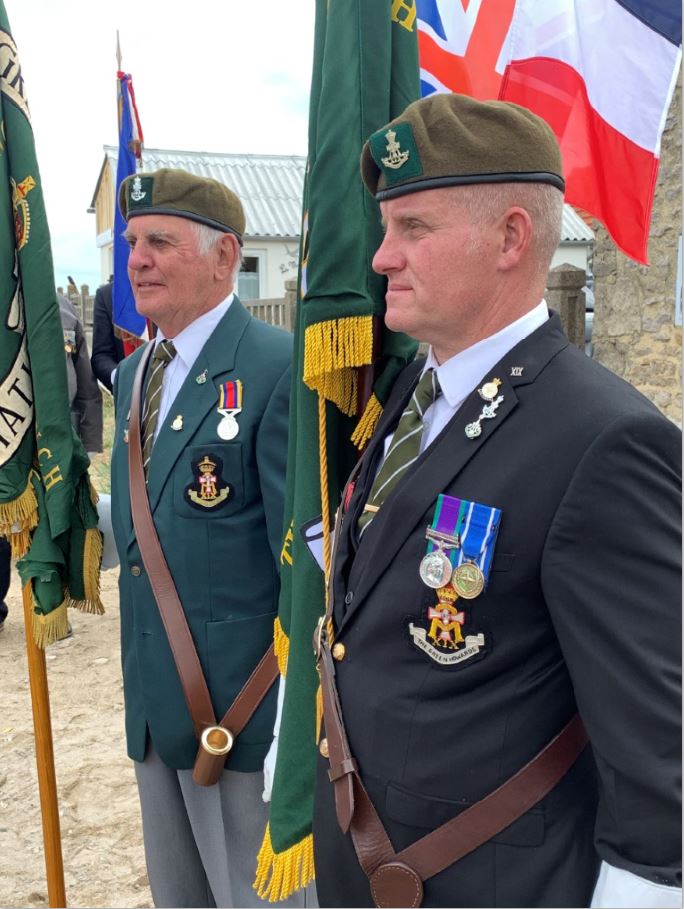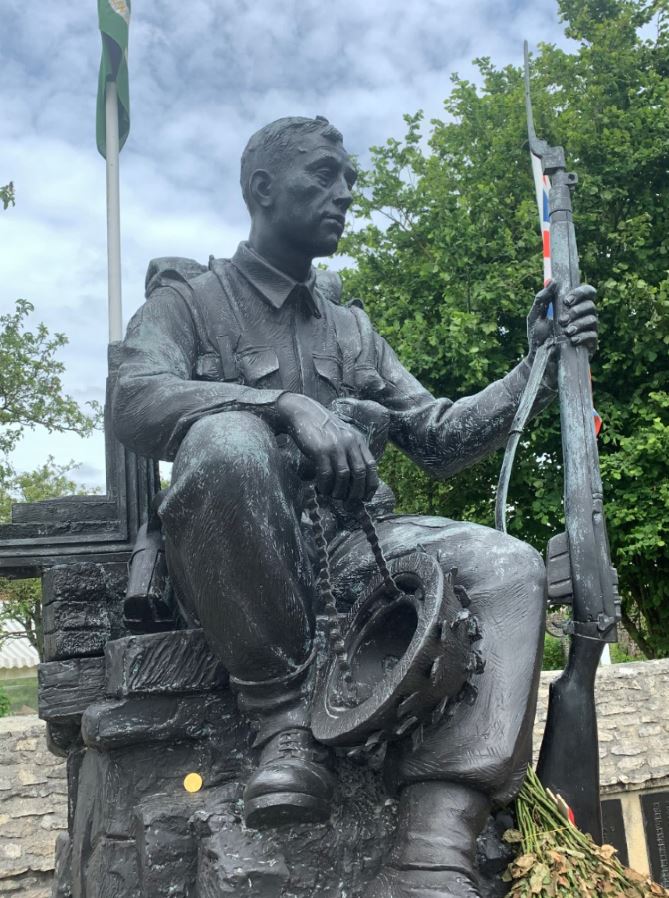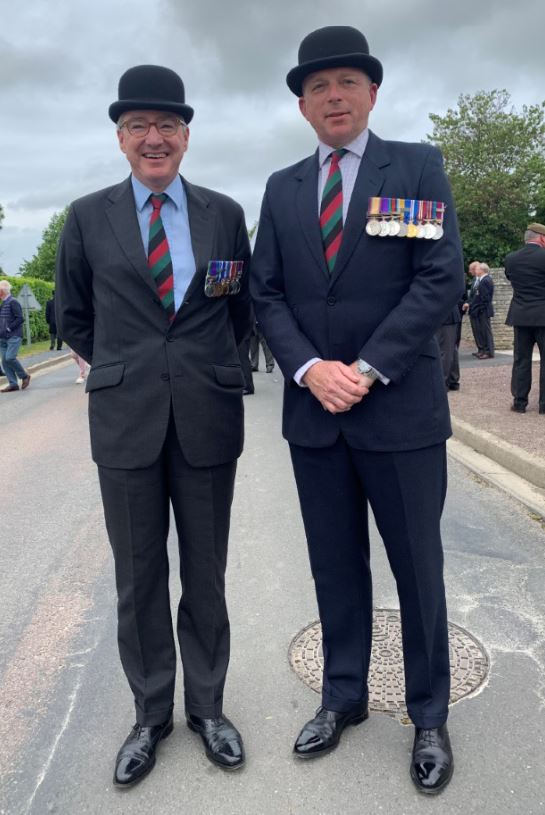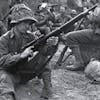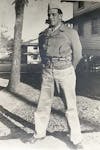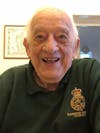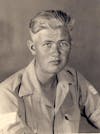45 Gold Beach Normandy trip WW2
Stories behind the sights at Gold beach & Omaha, WWII
Accounts of my trip to Normandy - including Gold beach and Omaha.
An exclusive preview of the new British Normandy Memorial which is dedicated to the 22,000 British, French and other foreigners killed during the World War two Normandy campaign.
Some excellent D-Day passages from a book I’ve been reading about the D-Day landings, D-Day the Battle for Europe.
"There was little sleep that night. The first squadrons were off in the night."
"There was a pause in the bombing attacks about four in the morning and my son climbed onto the wall to see what was happening. He started shouting, “Mummy, mummy, the sea’s black with boats. I knew that the invasion had started."
"We reached a landing craft and I was in a different world. All the men were wearing campaign ribbons and they were so calm. They were real men, real soldiers and I felt elated to be amongst them."
"I reached the sea wall and leaned against it to regain my breath. Other soldiers were doing the same. That was when I realised that some of our men were missing."
Normandy Memorial Trust Appeal - 75 veteran D-Day stories
Feedback/reviews in Apple Podcasts - Thank you.
Joël Stoppels Battlefield Tours
Victoria Second World War re-enactor

Crepon statue - Normandy WWII soldier
Crepon memorial “It’s been quite a day. I’ve lost many of my friends, and a lot of action lies ahead of me”

Attacking the beaches in Normandy - British Normandy Memorial at Ver sur Mer, Gold Beach

Casualty rates on the various beaches were around:
2,000 on Omaha,
1000 on Gold
1000 Sword – British
1000 approx Juno - Canadian
200 Utah - American
135 Pointe du hoc – also American
Source: Wikipedia (Figs rounded up)
Featured video for this episode - scroll down page
360 video of this magnificent memorial to 22,000 who died under British Command during the Normandy Campaign of WW2. Edit: I should mention that maybe I got a bit carried away referring to to the statue in connection with the 6th Green Howards. The statue is meant to be representative of all forces killed during the Normandy campaign. And even though Ver-sur-Mer is closest to gold beach, the statue is by no means representative solely of the gold beach landings.
Best podcast for World War 2 history and the second world war
Interested in Bill Cheall's book? Link here for more information.
Fighting Through from Dunkirk to Hamburg, hardback, paperback and Kindle etc.
Ze boys of Uncle Sam - French WW2 re-enactors
Map of area showing Arromanches and Omaha Beach
Note: Gold Beach can be hard to find
GPS coordinate for Gold Beach is:
49.20.42.92N 0.31.41.11.W
Gold Beach museum is great
The new Normandy Memorial is also in this area
Re-enactors at Crepon - world war two
Standard bearers Green Howards/Yorkshire Reg
Crepon - Two fine looking bowler hatted officers enjoying the atmosphere of the ceremony at Crepon
Note: Does not contain the passages from the book
This is the Fighting Through Podcast - Episode 45 - Normandy Gold Beach trip -Day 75, with the Yorkshire Regiment
I’m Paul Cheall, son of Bill Cheall, whose WWII memoirs have been published by Pen and Sword – in FTFDTH. The aim of these podcasts is to give you the stories behind the story. You’ll hear first-hand memoirs and memories of veterans connected to Dad’s war in some way – and much more.
I recently went on a battlefield tour to Normandy, France with Leger Holidays. It was organised by the Green Howards, my Dad’s old regiment, though they are now part of the Yorkshire Regiment – (of the Second world war.)
This episode was kindly introduced by a French girl, Victoria, whom I met in France on a recent visit. She was part of a French world war two re-enactment group dressed in Civilian clothes – more on Victoria later.
I’m going to share my accounts of the visit - which includes Gold beach as well as a very brief visit to Omaha plus what proved to be a very lucky exclusive preview of the brand new magnificent British Normandy Memorial which is dedicated to the 22,000 British, French and other foreigners killed during the World war two Normandy campaign under British command.
The visit included an excellent trip to the Menin Gate at Ypres, of First World war fame
To cap it all off, I’ve got some excellent D-Day passages from a book I’ve been reading about the D-Day landings.
If you’re wondering about the new intro music you heard, there’s great news – I’ve finally stumbled upon the long sought after drumming tune that I’ve wanted to use in the show. More to follow on *that* shortly.
So I’ve got an absolute stack of material for you but I’m going to kick off by getting straight down to Gold Beach.
If you’re driving, watch out for the traffic, if you’re flying, keep an eye open for Messerschmitts. If you’re riding a horse, watch out for cars!
In all cases, do not let a podcast distract you from your work in hand. If you can, close your eyes, relax and enjoy.
One more thing – do not stop listening till you hear the music play. If you do you’ll miss the usual PS at the end – usually a short story to end the show. And today there’s also a PPS, so switch over early to the next podcast on your list at your peril.
Transition
In 2004 Molly Burkett and the late Dick Barton published a book, D-Day, The Battle for Europe.
The Green Howards put me in touch with Molly who kindly gave me permission to use a few passages from the book.
I’ve chosen the book because it has such a great variety of first-hand stories which illustrate D-Day from so many angles. It offers perspectives from all the beaches, nationalities and weaponry and it’s a real pocket rocket of a book.
Co-author Dick Bowen was in the Fifth E. Yorks on D-Day. He was in the thick of it with the first wave landing on gold beach on King red sector right next to my dad’s, which was king green.
If you want to hear more about the Fifth E. Yorks landing you could catch up with episode three of the podcast which features the memoir of Sergeant Brian Moss of the Royal engineers. Brian illustrated what an awful time the regiment had on Gold beach, with enfilade fire screaming across the beach and wreaking havoc with the poor East Yorks who took a real hammering.
I didn’t think you could beat Brian Moss’ account, yet here we are with another which I reckon at least equals it. So pull your helmet straps tight sergeant and get ready …
........
Dick once observed that “Some people think Gold Beach was a picnic compared to Omaha and other places,"
But he’d always respond: "To them I say: 'You weren't there'."
And I think if you’ve listened to both Dick’s account and that of Mike Moss, you might well believe him.
Just to set the record straight about the casualty rates on the various beaches
Casualties were around
2,000 on Omaha,
1000 on Gold
1000 Sword – Another Britisg Beach
Juno – a shade under 1000 - Canadian
200 Utah - american
135 Pointe du hoc – also american
So Omaha does appear to have received the worst hammering of the lot with 2000 casualties, twice what Gold Juno and Sword each received. But in support of Dick’s viewpoint, I suspect that in truth whatever beach we’re talking about, the first wave would all have received a pretty brutal lashing from the enemy defenders
and Molly’s book is still available new and well worth a full read. At the time I bought it I could only find a second hand copy from Amazon but to my very pleasant surprise it had both Dick and Molly’s autographs in! I’d bought it on recommendation while I was actually on the coach in France. So what a recommendation that was!
It’s quite a modest little paper back but it is stuffed with info and would actually make a great accompaniment to any second world war battlefield holiday, a bit like the Fighting Through world war two podcast really!
So that’s D-Day, The Battle for Europe. By Dick Bowen and Molly Burkett . There’s a link in the show notes [for this second world war podcast].
I’ve got several more extracts to share with you later in the episode.
Interlude
Feedback time
Facebook:
Michael Nibbi
I love hearing all of the interviews with veteran Wilf Shaw. His stories mean so much to me. Both my grandfathers served in ww2, one in the Pacific the other in Europe. I never got the chance to talk to either regarding what happened.
Pat Sachs
Lovely pics of Wilf playfully and thoughtfully regarding this Brodie helmet. With his shirt, tie, and cardigan, he looks as if he was a natty guy well into great old age. I am so glad his helmet saved his life at El Alamein. Wilf, wherever you are, I salute you.
Leigh Owen
I’m on episode 16 (Gallipoli) and BLEEP fuck me!! Reynard is a legend. As are the men who partook in that nonsense. I’m glad it was my great grandfathers and grandfathers who did. I wish I could have told them how proud I was of them but I didn’t know then.
Leigh Owen Caerphilly Wales.
Famous for its cheese isn’t it? Caerphilly? I Googled it and apparently it’s a hard white cheese. I found someone selling it online so here’s a random shout out for Tom Pinder, founder of The Welsh Cheese Company and his lovely gift packs - there’s a link in the show notes. Sadly he can’t post out of the UK because apparently the cheese melts – who’d av thunk it!?
Messenger
Hi there from New Zealand,
I’m loving your podcast. My Grandad (Dads father) fought in the 1st Echelon in Egypt and was in signals. He came home with "Sand on the Lungs", probably quite common I would guess.
My Poppa (Mums father) was in the Royal merchant navy during ww2. He had sea legs and loved it more than his home life after the war. He was on the ice route up to Murmansk. I can’t think of anything worse!
I must admit I shed a tear at the end of Episode 7 about Sergeant Grey. How sobering.
Thanks again Andy Tucker
PS I am organising a tabletop wargame here of about 9 players to commemorate the D-Day landings. We are doing a SWORD beach landing scenario.
Thanks for that Andy – sounds like you’ve got quite a military heritage in you there. I’ve put some of your wargame pics in the show notes – and what a great little 3-D representation of Sword beach. But Gold Beach is where it’s at mate – If you give that a go some time let me know and I’ll send you some ideas for scenarios to re-enact!
A few emails
Thank you for your effort and content in your show. I’ve loved history ever since I was a kid, I went on to graduate with a degree in History from the University of Birmingham and I’m currently travelling around Australia.
Listening to your podcast is a fantastic way of “topping myself up” with military history, as quite often I don’t have the time to read or even access books.
Tom Lyon - Email July 2019
Please keep marching forward. Those heros are leaving us quickly nowadays.
From another veteran from another era.
David Braun – former American marine Email
I’ve had positive feedback from all these people …
Podbean:
odaaron, derekwhittle, simyan, DQX, RNJ – come on guys get a life with some of these user names! And finally hansime who cheered me up no end.
Apple - by andy-calif from United States of America
Feedback of the month:
Amy Bryant - Michigan USA - Email
I have been binge listening to your podcast for several months now. I drive A LOT for work and listen to it in the car. Actually, more than once, I've been so absorbed in a story that I've missed turns I was supposed to take and had to back-track. Please know the time and energy you put into research for your podcast shows and puts your show head and shoulders above other podcasts.
I too have a deep respect and reverence for soldiers and veterans. And I love learning about wars. Being from America, we're really only taught about the battles Americans were in (I imagine selective teaching is typical of most countries). So when I came across your podcast I was very intrigued. This was a whole other side to the war from what we learn in school or movies. I was very excited!
Amy thanks so much for all that, I think you’re right about selective teaching in countries. In fact when I was at school we never actually got taught about the second world war – maybe they thought our parents would tell us – but I think part of it was about forgetting animosities and building bridges because of course I was amongst the first generation born after the war. And by ‘eck times were ard in them days!
Amy’s also written some great things about her German grandfather and I’m going to include that in a forthcoming episode dedicated to the German side of the war, so if YOU have any German-related stories to tell, please get in touch asap!
Amy thanks again – keep listening but do drive carefully so you don’t get lost on those roads or worse
Apple Podcasts by HPFOBE from Belgium on August 11
Gilbert Dunkley Facebook - Thanks
Glen Marshall, UK email 20 Aug 19
Michael Thomson - Johannesburg, South Africa. Email - Heartstopping and sometimes heartwrenching accounts of the mens' experiences .
I sadly don't get much time to read as I am an airline pilot and work ridiculous hours and basically have to get sleep whenever I get the chance but I am definitely going to get your dad's book and it is going to the top of the long 'to read' list of books on my Kindle.
Thanks for that Michael – do fly safely captain – or is it wing commander?!
And thanks to those many people who’ve linked or followed me recently. I can’t name them all but welcome aboard guys and thanks for your support. I could go on, but you’re probably thinking, you already have done, so I’ll push on now with another short story from the book we’re reading …
Trans
Just to further set the scene for our visit to Gold beach
66 Shopkeeper at Arromanches
Gold visit
9th June 2019. It was seriously tough crossing the English channel between Portsmouth in England and Cherbourg in France.
The weather was atrocious and no-one could help comparing the effects of that sea with what it must have been like for the poor wretched soldiers, exactly 75 years and three days earlier.
I am sure it would have been far worse for them because they had a two hour run in on an LCA – landing craft assault, after they’d left their ship.
The atmosphere was just brilliant as our full coach load of assorted former Green Howards and Yorkshire Regiment, friends and family, made our way to the battlegrounds of Normandy.
To mark the 75th anniversary of D-Day the French towns and villages were well and truly up for it, with flags and decorations everywhere. And there were loads of war re-enactors dressed up for the occasion, with tanks trucks and all sorts of world war 2 paraphernalia lining the roads - it made for an absolutely splendid visit.
>>> Music – Rufty’s Riff
I never thought this day would come. In episode 25 I told the story of Lance Sergeant Rufty Hill who was killed on Gold Beach on D-Day and how he and his pals turned out to be members of the regimental band. I finished that poignant tale with a quest to find some music, which I labelled Rufty’s Riff, which we could play occasionally on the show. Well, I’ve worked quite hard on this over the months. And you’d think it would be quite easy to find something which represented that rousing beating drum march that we’ve all heard in our towns or cities from time to time. But it’s been quite frustrating really even though I’ve searched online quite extensively. I guess I wasn’t looking in the right places because in the end it just dropped onto my lap.
On the first morning after our arrival I turned up on the sands of Gold beach for the commemorative ceremony organised by the Green Howard’s the Yorkshire Regiment.
And they had only just organised the Royal British Legion band to turn up to begin proceedings. They marched up the little lane towards the beach, bashing out the most marvellous rhythmic tune lead, of course, by various drummers.
When I enquired, I was told it was the adopted green Howard’s regimental March and is in fact called Bonnie English Rose. And what a great tune it is. Just perfect!
There is a passage in Dad’s book about a tiring overnight exercise that the troops went on in the freezing cold and what happened the next morning.
“I remember one thirty-mile march we did and we all felt a bit rough during the last five miles when, suddenly, two three-tonners turned up – the regimental band had arrived to accompany us, and we didn’t half step it out. I have never forgotten that and, even today, many a time I tap that tune out with my fingers. Arriving back at camp the mobile showers were awaiting us.”
I can’t help wondering if the tune Dad remembered was Bonnie English Rose.
You’ve been listening to my live recording of the band and you can actually buy a studio recording of it from most online sellers. It is one track of several on a special green Howard’s album. There is a link in the show notes [for the second world war.] You can also see a video of the band playing it in the show notes.
Right now I can’t get it out of my head and of course recording this podcast with it has made things even worse!
Major (Retired) Tony Warriner MBE said
“It is the Regimental March - The Quick March – The Green Howards. Whenever it is played Green Howards would stand to attention if not marching. If played in the Sergeants’ Mess after dinner, members would stand to attention at the table”
From now on, I will be using the music occasionally if it befits the story being told and you’ll certainly be hearing more of it as time goes on – I might also play it occasionally just for the hell of it, so keep yer ears peeled sergeant!
Back to the visit
So on our first full day we made our way to Gold Beach, what I call Gold Beach proper, because a lot of people think Arromanches was Gold Beach. And it was, in fact it was captured by the British Hampshire Regiment at a cost of 64 precious lives, but it’s not the place where the initial landings took place.
Somehow what I think of as Gold Beach gets missed by most battle commentaries and even by the tourist brochures - most of them preferring to focus on the tangible glamour of the famous Arromanches Mulberry Harbour, the artificial port, the remains of which can still be seen today. You can even stand on them when the tide’s out.
Arromanches is where all the shops and eateries are and a great museum, and it’s where most of the local history re-enactors hang out - so it’s always worth a visit. And here’s a quick Quiz for you – why was the Mulberry harbour so-called? Answer at the end in the Postscript, which in this episode is about a lady who discovered her late husband’s war grave in the most unexpected circumstances.
So to get to Gold landing beach you need to travel just about five miles East, where there’s a turn off which if you blink you’ll miss it. There’s a GPS coordinate and map in the show notes.
There’s a turn off signposted 50th Division Avenue which you travel down for just a few hundred yards. At the end there’s a quiet and unassuming beach entrance used by fishermen. Plenty of free parking. Go forwards and at a certain time of year you’ll be met by the cold, dark, brooding sea and sand that were once turned red by over a thousand soldiers.
Looking out to sea you might struggle to fully imagine the organised chaos of many thousands of water craft and planes, strewn along the coast line, delivering cargos of death to the defending enemy. I say struggle because it seems like every description you ever read of this scene is prefaced with the words, “it’s hard to describe but …!”
I could just picture my Dad jumping off the landing craft into four feet of water, dodging bullets and seeing the blokes in front and behind him go down, as he struggled up the sand before he could seek temporary shelter behind the sea wall. Just a few hundred yards away Sgt Brian Moss of the Royal Engineers was experiencing similar.
My video is in the show notes.
Coming back from the beach you’ll pass the Green Howards tram shelter, often referred to as Stan Hollis’s hut, because it was shot up by Stan as his landing craft approached the beach, on his way to winning the only VC to be awarded on D-Day. That’s the Victoria Cross, Britain’s highest honour for bravery, I believe equivalent to America’s medal of honour. Stan shot some rounds at the shelter thinking it was a pill box, burning the palm of his hand in the process.
Look carefully at Stan’s hut and you can still see his bullet holes on the corner of it.
One day I’d love to hire a boat and have someone bring me onto the beach at H-hour so I can do a running commentary on what my Dad and his pals went through at each stage of their assault. Mind you I don’t want to repeat that two hours run in which *he* had to experience. Half a mile will do me I reckon.
On this occasion around seventy people congregated around the hut area for a commemorative ceremony. The regimental colours were being carried and there were French officials and civilians as well as several French children.
So proceedings started off with the marching in of the band playing Bonnie English Rose.
Then the local French Mayor made an address followed by Colonel Mantell of the Green Howards Association. Then some French people including the little children laid a wreath at the hut, which has now become a veritable shrine for all visitors to Gold. It’s actually been bought by the Green Howards, refurbished, and relocated slightly from where it used to be.
We then heard a bugle call Aux Morts – to the dead - followed by a minutes silence.
I’m posting all my photographs and one or two videos to the web site, but I took so many videos I’m posting most of them to my YouTube channel – there’s a link in the show notes, as usual. But if you do only one thing, take a shufty at the video of the band playing Bonnie English Rose in rousing fashion – it is just great – you will want to keep watching it over and over again. Netflix eat yer heart out! I’m putting a stack of photos in the show notes too so I’m really spoilt for choice as to what to post at the top of the page. But I’ve got some good ideas.
Interlude
You’re listening to the Fighting Through Podcast, Episode 45 Normandy trip – Great Unpublished History – Best podcast for World War 2 history and the second world war
One last bit of feedback before I read another memoir
Misc
Davy McLean contacted me with what, for me, were very poignant photos of the D-Day preparation camp at Inveraray Scotland. It's exactly where the combined ops training took place which my Dad took part in. They were doing practice landings in landing craft and climbing across rivers on ropes and allsorts.
I hope it’s warmer these days than it was back when my Dad, Sgt Brian Moss and the late Wilf Shaw all had to complete the course. It's now a campsite but there are some original buildings and a very poignant memorial which says.
"This stone is dedicated to the men and women who trained here and especially to those who did not return” Oooo that is so - I don’t know – My dad’s comrade Rufty Hill would have been here. He was killed on the beach landing on D-Day – so all that training was to no avail. And I love that the memorial is to both the survivors and those killed. We’ll hear more about Rufty in a short while.
Episode 43 on D-Day 75 will give you more background to the Inveraray training experience. Davy, thank you so much for taking the trouble to send those photos in. They’re in the show notes and Facebook page.
MY RELATIVE
Will Leggett
I always planned on joining the army and so sadly never asked my grandparents the right questions when they were alive (or remembered what they said), however after joining London Fire Brigade I discovered that it was whilst both serving in the AFS (Auxiliary Fire Service) in Middlesex (now part of the LFB) and then NFS (National Fire Service) that my grandparents met.
My grandma served as a driver for senior officers and my grandad as a firefighter, apparently he spotted her and in an effort to impress her decided to her cut her up with the fire engine. This led to a stern telling off from the officer she was driving, but obviously got her notice!
He also told my dad a story involving fighting a fire from the top of a ladder and hearing a bomb go whistling past him which killed or wounded the rest of his crew who were at ground level. Sadly that is all I have gathered about them, however my grandma also mentioned that her brother served as a navigator in the RAF, learning the colour blindness test off by heart to pass!
Keep up the good work.
Will Leggett
Transition
War Stuff
I’d like to give a shout out now for a new book that’s out for anyone who might have an interest in the troubles in Northern Ireland. It’s written by a former Green Howard, Tom Wharton.
Tom served in NI. On the first tour in 1970 and a further 9 tours ending with his last one in 1995 as Captain Quartermaster.
On the second of these tours he was badly wounded by an IRA booby trap claymore type Improvised Explosive device.
So I think Tom has well and truly earned the right, as a former practising soldier, to get this book published.
It’s called Operation Banner - The Green Howards in Ulster 1970-2004
And it’s a unique record of the history of the regiment during that period of time - from the notes written by various officers and soldiers who were there.
It’s got every tour and deployment in chronological order featuring hundreds of photographs.
I met Tom on the Green Howards trip so I saw the book in the flesh. It’s a big hardback A4 tome and very complete and accomplished it looked as well.
There is a link in the show notes with more information about the book
That’s Operation Banner - The Green Howards in Ulster, by Tom Wharton
Joël Stoppels Battlefield Tours
https://www.facebook.com/Battlefieldgroningen
@ Battlefieldgroningen
Quick shout out for Joel’s facebook page. For me it’s not just reading about his battlefield tours as much as he simply posts a great set of photos and videos from so many aspects of the European war. It’s mostly in Dutch but a quick touch of a link offers instant translations to English. And most of the comments are already in English I think it’s a bit like those movies with subtitles – you don’t mind watching them so long as they’re good. And Joel’s page sits firmly in that camp. There’s a link in the show notes.
Trans
Crepon
From Gold Beach, our party moved just a mile up the road to Crepon. There’s a map in the show notes that illustrates the local layout.
I think it’s an opportune moment to feed in a few passages from the book regarding the impact the invasion had on the local French people and their soldiers:
66 Shopkeeper
42 French
Also 88 – Here’s a couple of short passages about French troops landing on Sword beach:
89
We’re at Crepon. There is a memorial to the Green Howards killed on D-Day. We gathered around this for a service.
There is a statue of the lone soldier sitting down taking a rest with his elbow on his knee. The sculptor was James Butler and he’s managed quite brilliantly to create a soldier who is reflecting at the end of D-Day.
The expression on his face has been described to be saying something like, “It’s been quite a day. I have lost many of my friends and a lot of action lies ahead of me.”
Each and every green Howard who was killed on those beaches and beyond is remembered in the plaques just behind the statue. There is a video in the show notes.
Before the service took place I had the opportunity to interview Victoria briefly. She is the girl who opened the show for me. Here is the recording of our chat.
>>>Insert
Victoria thanks so much for that. Heartwarming that our two countries share similar sentiments about the occasion. Thank you for your re-enactment services because you and your friends added so much joy to the occasion.
There’s a video of Victoria and her friends in the show notes and we’ll hear more from Victoria at the end of the show – but that’s a secret till then!
Back to the ceremony
Before the ceremony, there was a march past by the Royal British Legion band, as earlier, again playing Bonnie English Rose.
This was followed by various addresses and prayers and laying of wreaths by Green Howards and French people.
The last post was played plus Aux Morts (to the dead), followed by prayers and then rousing renditions of the British National anthem and the French La Marseillaise.
As with so much of this episode, there’s an accompanying video in the show notes and if you watch it via my youtube channel, you’ll see someone has posted a rather poignant message against it:
Taffman Guyo June 20
“Nice little bar just down the road [L'Imprevu] & a local church with some airmen in the graveyard. My late Dad was in the Green Howards, not in Normandy though [North Africa & Italy]. We visited this memorial twice in his later years & the last time Dad [with my brother & nephew] left a British Legion wreath to his brothers in arms.
Your video brings back some happy memories for me, but what I wouldn't give for another hug from my Dad. Thanks Paul. 6th June 2019.
You know what Taffman? Get yourself to Crepon again some time, hum that Bonny English Rose Tune and find that Imprevu Bar – give them a bit of custom and try the local Calvados Brandy – I brought a bottle back with me and I had a glass of it last night and toasted our various WW2 heroes. There’s a reminder in the show notes!
Trans
Ver sur mer
After some light bites and beverages at the village hall we moved to Ver Sur Mer which is next to the site of the brand-new British Normandy Memorial, and it had only just been unveiled a few days prior on television.
The memorial is to record the 22,000 service personnel who gave their lives during the Battle of Normandy in 1944. It includes any foreigners fighting under British Command. The name of every one killed during the campaign is going to be displayed, including members of the British Merchant Navy as well as civilian losses, French in particular.
Full details are in the online brochure which I’ve mentioned before in this podcast. It includes some really fantastic photos of the Normandy campaign. Link in shownotes. [This has got to be the best history of the second world war WW2 podcast]
And what a fantastic location for the memorial. It’s on a gentle hillside which offers the most fantastic panoramic view of gold beach. The area was absolutely strewn with poppies, being June, and it is hard to imagine a better location. And the Mt Fleury gun battery is also close by – that’s where Stan Hollis performed some of the action which led to his VC being awarded.
You can see the landing beach area and Stan Hollis Hut in the distance as well as a fantastic view of Arromanches and the Mulberry Harbour.
The dynamic statue comprises three soldiers advancing together from the beach, each carrying a different weapon which was in frequent use, namely a Bren gun, the stalwart Lee Enfield rifle and a sten gun. My dad carried all three of those at different times during the war.
I’ve made a video and it’s in the show notes.
[More WW2 History in the making]
We didn’t know it at the time but the memorial was open to public viewing for only a few days following the 75th anniversary of D-Day. It was closed shortly afterwards and the statue is now boarded up!
Evidently, the site now has to be fully prepared with access roads and surfaces etc combined with, longer term, some educational facilities.
I’ve got no idea when it’s going to be reopened but if you are planning a visit it will be well worth while checking ahead to see if it’s likely to be open whilst you are there.
And, of course, not only does it make it convenient to include in your itinerary an obligatory visit to the gold Beach shrine which is Stan Hollis hut, but I’d thoroughly recommend the gold beach Museum at Ver-sur Mer as worthy of a visit. And not far up the road are the massive gun emplacements at Longue sur Mer. Added to the Mont Fleury Battery, there’s lots to see.
Arromanches
We only had a fleeting visit to Arromanches. It was and is the site of the artificial harbour – known as the Mulberry harbour. It was basically a temporary portable harbour that was prefabricated in Britain then taken across the English Channel in sections, then assembled where needed, which was at Omaha Beach and Gold beach, namely Arromanches. And this happened on 9 June and they were operational within a couple of weeks of D-Day.
The arc of the completed harbours was to be about five miles long, and contain around 10 miles of roadways, which is just staggering really and quite hard to imagine unless you’re looking down from the top of the cliff at Arromanches, where you can still see some of the remains of the British harbour.
The idea was partly to wrong foot the Germans as to where the allied landings were to take place and to facilitate the offloading of soldiers and supplies during the invasion.
Unfortunately, the heaviest storms in 40 years on 19 June devastated the American harbour and rendered it beyond repair. Thankfully the British one survived and was called Port – well, I’ll let you guess – the answer is going to be in the PS!
There is too much to tell you about Arromanches in this episode so I’m going to pick it up another time along with a few other places we visited connected to world war one
If you go to Arromanches, go to the D-Day museum. Go to the 360 degree movie on the hill top – exhilarating and lifting. Get yourself a little souvenir bottle of Normandy Brandy, Calvados, from one of the gift shops, and above all wander around the beach, ideally when the tide is out or you’ll drown, and you’ll come face to face with some of the gigantic remains of the Mulberry harbour. Oh – one more thing from any gift shop – they sell empty glass jars with a cork, labelled with the names of the various beaches. So choose your beach and fill the bottle with sand when you go there – makes a nice little souvenir.
If you have time find Les Bains d’ete – a lovely little French tea shop in the middle of town. When we arrived there was a group of strange-looking blokes in unmarked khaki uniform sitting outside. Well, I couldn’t resist a photo with them and it turned out they were French WW2 re-enactors. When I asked one of them who they were meant to be one swarthy scarey unshaven guy leant over to me and whispered, with a wide grin ‘We’re ze boys of Uncle sam!’
Dick Barton and Molly Burkett published a book called D-Day, The Battle for Europe.
Omaha
We arrived late on that first day so sadly a planned visit to Omaha beach was cut short. But not before we could at least see and understand how it came to be such a tough time.
At one end of the beach where we stopped, there was a massive bunker and it didn’t leave too much to the imagination to see how the American troops storming ashore would have been totally at its mercy. Perched at the end of one length of beach, the guns would have been pointing right along the length of the beach and no doubt some would have been set up on fixed lines, they really would have torn a brutal swathe of bullets into those troopers trying to land.
Of course, Omaha was the beach that featured in the movie saving private Ryan which by all accounts fairly accurately represents the horrors and dramas which took place on that beach.
The Atlantic wall was particularly strong here, with eight concrete bunkers housing big guns and pillboxes with anti-aircraft guns as well as fortified machine gun points.
We were actually at the Bedford Boys monument at VIERVILLE SUR MER, which depicts one brave soldier dragging a wounded comrade off the beach. The statue commemorates the 29th Infantry Division, especially the 116th Infantry Regimental Combat Team who stormed the beach on D-Day.
Intense enemy fire, underwater obstacles and heavy seas caused high casualties even before the troops reached the shore.
Inset 105
Here’s a couple of passages from the book:
P107
Sadly we must leave Omaha now, but not before I give a brief mention to the steep cliffs of Pointe du Hoc which is almost a must see for any visit to the area although on this occasion we
It’s just a few minutes’ drive around the coast from Omaha and is located at the base of cliffs and all the dramatic action which took place there is still to be seen, with bomb craters absolutely littering the top of the cliff.
Great place to visit and there is also a very good museum there. P 110
That almost concludes my accounts and I’m very sorry I haven’t covered Canadian Beach Juno, American Beach Utah nor really British Sword although I did cover a bit of Sword. I will try to include these in a future episode.
For now I’m going to tell you about our final must see stop off on the last night of our holiday.
Menin Gate
The remainder of our all too short trip was dedicated to some poignant WW1 battle sites which brought us all too soon to Belgium, Ypres and our final sobering and incredibly atmospheric meeting at the famous Menin gate, built in 1927. This traditional final salute to the fallen is played by the buglers in honour of the memory of the soldiers of the former British Empire and its allies during the first world war.
The atmosphere was absolutely incredible. You could cut it with scissors. Everyone was talking in whispers waiting for the start and it felt like you can hear the collective breathing of five hundred people, each and every one in awe of the surroundings and the special occasion.
This huge memorial is composed of a massive archway, which of course amplifies every sound. It’s dedicated to the British and Commonwealth soldiers who were killed in the region during World War I and whose graves are unknown.
All 54,000 of them are engraved on the walls of the memorial, which is one of the most well-known war memorials in the world.
If a soldiers remains are ever dug up and identified, as sometimes still happens even today, then their name is erased from the monument. And it’s usually during building construction or roadworks that this happens.
Since 1928 the last post has been played live every evening at 8 pm and it was only during the Second World War that the ceremony was interrupted.
It commemorates casualties from the forces of Australia, Canada, India, South Africa and United Kingdom who died in the region known as the Ypres Salient.
Depending on dates, New Zealand servicemen and more from United Kingdom are named on the memorial at Tyne Cot, a site which marks the furthest point reached by Commonwealth forces in Belgium until nearly the end of the war. And more New Zealand casualties are commemorated on memorials at Buttes [Beaute] New British Cemetery and Messines [Messeen] Ridge British Cemetery.
The WW1 Menin Gate isn’t that far from WW2 Dunkirk so it’s always an option to double up and visit both locations if you’re touring the area. And Ypres as a town is absolutely lovely – just steeped in history at so many levels.
There’s a link in the show notes worth exploring which includes a daily timetable for who is attending at the Menin gate and if you apply far enough in advance, you can request to play a part in the ceremony by laying a wreath.
In our case, the Yorkshire regiment were there officially and we were also accompanied by a fine choir and piper.
“If you want to share in showing respect for a generation of young men who sacrificed everything, go. You'll not regret it, no matter what your age, views or beliefs. Trip Advisor
https://www.lastpost.be/en/home
Interlude
You’ve been listening to the Fighting Through Podcast, Episode 45 Gold Beach Normandy WWII trip – Great Unpublished History –
WW2 and WWII
Thank you for your support and thanks so very much for making the time to listen to me. Please do hear me next time.
Next episode
www.Fightingthroughpodcast.co.uk
Next episode
My Grandfather was an Unteroffizier in charge of a small recon squad, sent out to investigate rumours of tanks - and fortunately they were equipped with a few Panzerfaust anti-tank weapons …
For a couple of days the two sides just existed on opposite sides of a meadow with a tense safety. The Germans could hear the Americans sing songs in the evening, and likely vice versa. Then, one morning the engines of the Sherman tanks came to life …
The day that my grandma got her drivers license in late 1945, she was on her way home from the Dept of Motor Vehicles when somehow she T-boned a truck carrying a load of German POWs …
Yes, it’s Germans. I’ve been lucky enough to track down a few stories to share with you sent in by listeners. If you know any more please do send them in, even if you think you’re listening late – they’ll always get used.
…..
So there yer go – Episode 46, Through German eyes, on your best second world war history podcast
Also coming in the next few months is going to be episode 50, so I’m going to celebrate with a review of my favourite moments and episodes from the show and I’d love it if you would participate. So if you have a favourite part of the show you’d like included drop me a line through the web site. And if you’ve previously given me feedback through the online survey I’ll be taking all those comments on board as well.
You’ve been listening to the Fighting Through Podcast, Episode 45 Gold Beach Normandy Battlefields trip – Great Unpublished History –
Thank you so much for listening. Please do hear me next time. And in case you missed me saying it earlier – there are loads of videos in the show notes – I’ll meet up with you there!
Music?
PS
Why was the Mulberry harbour at Arromanches so-called? If you said it was because some of the pieces were shaped like a Mulberry … you’d be wrong. Apparently M for Mulberry was the next letter in the code numbers allocated for secret projects by the British war ministry! I have no idea what the previous letters all stood for mind you except for this old chestnut – what did the D in D-Day stand for? Well, apparently it stood for Day. Like H-Hour stood for Hour etc etc – there yer go – you learn something new about world war two every time on the fighting through podcast.
And what was the British Mulberry Harbour called? If you thought long enough you’d probably have been able to guess it was christened Port Winston, what else.
To finish, this is such a poignant story about Joan Poole and how she lost her husband during the war but then found him again many many years later. This, again, is from D-Day The Battle for Europe
>>>> Insert passage from page 68.
Thank you very much if shared the podcast with a friend or on social media. A lot of people did and it’s done my history download figures a world of good.
Have were finished? No. There’s a PPS coming up!
First just a final reminder - I do need some ideas for anniversary special episode 50 please. What is your favourite episode or clip and why? And any German anecdotes greatly appreciated for episode 46 - or beyonnnnd!
Before that I’ll say thank you to the friendly folk from the Green Howards Association and the Yorkshire Regiment for their great hospitality and company, particularly Major Tony Warriner Retired MBE for his hard work in organising the event, together with Steve Erskine from the Green Howards Museum in Richmond Yorkshire.
Also thanks to Ze Boys of Uncle Sam re-enactors who were a great bunch at Arromanches and French girl Victoria and all her fantastic world war two re-enactment friends who did so much to spice up the event taking place at Crepon.
Finally a very special thanks to Molly Burkett for allowing me to feature her great book on this episode. It’s certainly one worth a read for a compact overview of the war zones along with some super stories to illustrate what happened.
Here’s just one more great passage from that book. It’s about a German soldier, H Schmidt, talking about being on guard duty and it’s a convenient way to link through to the next episode, which is, 46 - World War Two - Through German Eyes. Don’t miss it.
Bye bye now!
“It’s been quite a day. I’ve lost many of my friends, and a lot of action lies ahead of me”
WW2 and WWII
http://www.Fightingthroughpodcast.co.uk
If you want to comment on or share what you've heard so far you can do so via the contact page at ftp.co.uk. Whether you're after social media or feedback you'll find all the links there. You might have ideas or even contributions to the show.
If so I'd be delighted to hear from you. In particular if you’ve enjoyed listening and you think other people would enjoy it, please rate the series on iTunes or your usual service provider as doing this does help raise the profile of the podcast in the search engines etc.
This is the Best World war two podcast for great unpublished history
There was little sleep that night. The first squadrons were off in the night.
My son started shouting, “Mummy, mummy, the sea’s black with boats. I knew that the invasion had started.
We reached a landing craft and I was in a different world. All the men were wearing campaign ribbons and they were so calm. They were real men, real soldiers and I felt elated to be amongst them.
Royal British Legion Band marching on Gold Beach, playing Bonnie English Rose.
Ww2, wwii, Bonnie English Rose,
Royal British Legion,
Yorkshire Regiment, Normandy, Gold Beach, Green Howards, Service, D-Day 75,
Ver sur Mer, British Normandy Memorial,
Ypres, Menin Gate, Yorkshire Regiment, Green Howards,
Featured Episodes
If you're going to binge, best start at No 1, Dunkirk, the most popular episode of all. Welcome! Paul.
PS. Just swipe left to browse if you're on mobile.










